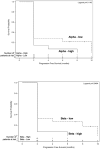Farnesyl transferase expression determines clinical response to the docetaxel-lonafarnib combination in patients with advanced malignancies
- PMID: 21365629
- PMCID: PMC3131496
- DOI: 10.1002/cncr.26004
Farnesyl transferase expression determines clinical response to the docetaxel-lonafarnib combination in patients with advanced malignancies
Abstract
Background: Lonafarnib (LNF) is a protein farnesyl transferase (FTase) inhibitor that has shown synergistic activity with taxanes in preclinical models and early stage clinical trials. Preclinical findings suggested tubulin acetylation and FTase expression levels may be important determinants of drug sensitivity that would help identify patient populations more likely to benefit from this regimen. This pilot study evaluated the biological effects of LNF and docetaxel (DTX) combination therapy in refractory solid tumors by comparing pretreatment and post-treatment tumor biopsies.
Methods: Patients with histologically confirmed locally advanced or metastatic solid malignancies refractory to standard therapies or with no effective therapies available were eligible. Patients were randomized to 1 of 4 dosing cohorts: 1) 30 mg/m², 100 mg; 2) 36 mg/m², 100 mg; 3) 30 mg/m², 150 mg; or 4) 36 mg/m², 150 mg of DTX intravenously weekly, LNF orally twice daily, respectively.
Results: Of the 38 patients enrolled, 36 were treated, and 29 were evaluable for toxicity and response assessment. The combination of LNF and DTX was tolerated in all cohorts with the exception of a 28% incidence of grade 3/4 diarrhea, which was manageable with aggressive antidiarrheal regimens. Seven patients derived clinically meaningful benefit from this combination treatment; these patients had significantly lower basal FTase-beta mRNA expression levels than the mean study population level (P < .05). Correlation of clinical benefit with tubulin acetylation content as well as basal acetyl-tubulin content were evaluated. However, no significant correlation was found.
Conclusions: Despite the small number of patients, these findings support our preclinical mechanistic studies and warrant further clinical investigations using FTase-beta mRNA expression as a potential predictive biomarker to select for an enriched patient population to study the effects of taxane and FTase inhibitor combination therapies.
Cancer 2011 © 2011 American Cancer Society.
Figures






Similar articles
-
A phase I safety, pharmacological, and biological study of the farnesyl protein transferase inhibitor, lonafarnib (SCH 663366), in combination with cisplatin and gemcitabine in patients with advanced solid tumors.Cancer Chemother Pharmacol. 2008 Sep;62(4):631-46. doi: 10.1007/s00280-007-0646-x. Epub 2007 Dec 6. Cancer Chemother Pharmacol. 2008. PMID: 18058098 Free PMC article. Clinical Trial.
-
Phase I study of the farnesyltransferase inhibitor lonafarnib with paclitaxel in solid tumors.Clin Cancer Res. 2004 May 1;10(9):2968-76. doi: 10.1158/1078-0432.ccr-03-0412. Clin Cancer Res. 2004. PMID: 15131032 Clinical Trial.
-
Phase II trial of erlotinib and docetaxel in advanced and refractory hepatocellular and biliary cancers: Hoosier Oncology Group GI06-101.Oncologist. 2012;17(1):13. doi: 10.1634/theoncologist.2011-0253. Epub 2011 Dec 30. Oncologist. 2012. PMID: 22210086 Free PMC article. Clinical Trial.
-
Lonafarnib for cancer and progeria.Expert Opin Investig Drugs. 2012 Jul;21(7):1043-55. doi: 10.1517/13543784.2012.688950. Epub 2012 May 24. Expert Opin Investig Drugs. 2012. PMID: 22620979 Review.
-
Phase I study of weekly CPT-11 (irinotecan)/docetaxel in patients with advanced solid tumors.Lung Cancer. 2002 Aug;37(2):213-8. doi: 10.1016/s0169-5002(02)00081-8. Lung Cancer. 2002. PMID: 12140145 Review.
Cited by
-
Targeting protein prenylation for cancer therapy.Nat Rev Cancer. 2011 Oct 24;11(11):775-91. doi: 10.1038/nrc3151. Nat Rev Cancer. 2011. PMID: 22020205 Free PMC article.
-
The FNTB promoter polymorphism rs11623866 as a potential predictive biomarker for lonafarnib treatment of ovarian cancer patients.Br J Clin Pharmacol. 2015 Nov;80(5):1139-48. doi: 10.1111/bcp.12688. Epub 2015 Jul 22. Br J Clin Pharmacol. 2015. PMID: 26033044 Free PMC article. Clinical Trial.
-
CRISPR/Cas9 genome-wide loss-of-function screening identifies druggable cellular factors involved in sunitinib resistance in renal cell carcinoma.Br J Cancer. 2020 Dec;123(12):1749-1756. doi: 10.1038/s41416-020-01087-x. Epub 2020 Sep 24. Br J Cancer. 2020. PMID: 32968206 Free PMC article.
-
Microtubule Engagement with Taxane Is Altered in Taxane-Resistant Gastric Cancer.Clin Cancer Res. 2020 Jul 15;26(14):3771-3783. doi: 10.1158/1078-0432.CCR-19-3018. Epub 2020 Apr 22. Clin Cancer Res. 2020. PMID: 32321717 Free PMC article. Clinical Trial.
-
BRCA1 regulates microtubule dynamics and taxane-induced apoptotic cell signaling.Oncogene. 2014 Mar 13;33(11):1418-28. doi: 10.1038/onc.2013.85. Epub 2013 Mar 25. Oncogene. 2014. PMID: 23524581 Free PMC article.
References
-
- Gibbs JB, Graham SL, Hartman GD, et al. Farnesyltransferase inhibitors versus Ras inhibitors. Curr Opin Chem Biol. 1997;1:197–203. - PubMed
-
- Haluska P, Dy GK, Adjei AA. Farnesyl transferase inhibitors as anticancer agents. Eur J Cancer. 2002;38:1685–1700. - PubMed
-
- Basso AD, Mirza A, Liu G, Long BJ, Bishop WR, Kirschmeier P. The farnesyl transferase inhibitor (FTI) SCH66336 (lonafarnib) inhibits Rheb farnesylation and mTOR signaling. Role in FTI enhancement of taxane and tamoxifen anti-tumor activity. J Biol Chem. 2005;280:31101–31108. - PubMed
-
- Bos JL. ras oncogenes in human cancer: a review. Cancer Res. 1989;49:4682–4689. - PubMed
-
- Slebos RJ, Kibbelaar RE, Dalesio O, et al. K-ras oncogene activation as a prognostic marker in adenocarcinoma of the lung. N Engl J Med. 1990;323:561–565. - PubMed
Publication types
MeSH terms
Substances
Grants and funding
LinkOut - more resources
Full Text Sources

